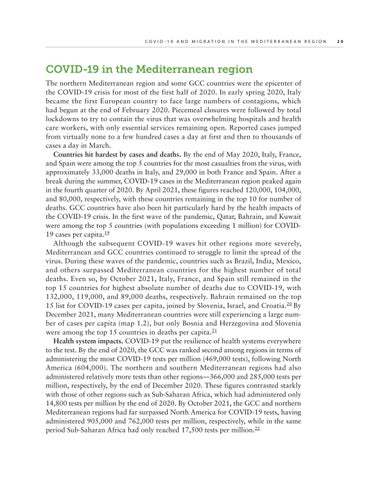C OVID - 1 9 a n d M i g r a t i o n i n t h e M e d i t e r r a n e a n R e g i o n
COVID-19 in the Mediterranean region The northern Mediterranean region and some GCC countries were the epicenter of the COVID-19 crisis for most of the first half of 2020. In early spring 2020, Italy became the first European country to face large numbers of contagions, which had begun at the end of February 2020. Piecemeal closures were followed by total lockdowns to try to contain the virus that was overwhelming hospitals and health care workers, with only essential services remaining open. Reported cases jumped from virtually none to a few hundred cases a day at first and then to thousands of cases a day in March. Countries hit hardest by cases and deaths. By the end of May 2020, Italy, France, and Spain were among the top 5 countries for the most casualties from the virus, with approximately 33,000 deaths in Italy, and 29,000 in both France and Spain. After a break during the summer, COVID-19 cases in the Mediterranean region peaked again in the fourth quarter of 2020. By April 2021, these figures reached 120,000, 104,000, and 80,000, respectively, with these countries remaining in the top 10 for number of deaths. GCC countries have also been hit particularly hard by the health impacts of the COVID-19 crisis. In the first wave of the pandemic, Qatar, Bahrain, and Kuwait were among the top 5 countries (with populations exceeding 1 million) for COVID19 cases per capita.19 Although the subsequent COVID-19 waves hit other regions more severely, Mediterranean and GCC countries continued to struggle to limit the spread of the virus. During these waves of the pandemic, countries such as Brazil, India, Mexico, and others surpassed Mediterranean countries for the highest number of total deaths. Even so, by October 2021, Italy, France, and Spain still remained in the top 15 countries for highest absolute number of deaths due to COVID-19, with 132,000, 119,000, and 89,000 deaths, respectively. Bahrain remained on the top 15 list for COVID-19 cases per capita, joined by Slovenia, Israel, and Croatia.20 By December 2021, many Mediterranean countries were still experiencing a large number of cases per capita (map 1.2), but only Bosnia and Herzegovina and Slovenia were among the top 15 countries in deaths per capita.21 Health system impacts. COVID-19 put the resilience of health systems everywhere to the test. By the end of 2020, the GCC was ranked second among regions in terms of administering the most COVID-19 tests per million (469,000 tests), following North America (604,000). The northern and southern Mediterranean regions had also administered relatively more tests than other regions—366,000 and 285,000 tests per million, respectively, by the end of December 2020. These figures contrasted starkly with those of other regions such as Sub-Saharan Africa, which had administered only 14,800 tests per million by the end of 2020. By October 2021, the GCC and northern Mediterranean regions had far surpassed North America for COVID-19 tests, having administered 905,000 and 762,000 tests per million, respectively, while in the same period Sub-Saharan Africa had only reached 17,500 tests per million.22
2 9

